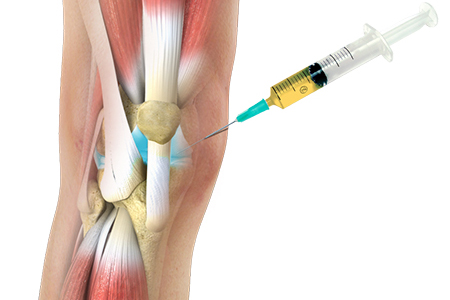What Are Platelet-Rich Plasma (PRP) Injections for the Knee?
 Platelet-rich plasma (PRP) injections for the knee are a regenerative therapy for knees designed to reduce knee pain, improve joint function, and promote healing in knee injuries or degenerative conditions like knee arthritis. This minimally invasive treatment uses the patient's own blood, which is processed to concentrate platelets, growth factors, and other proteins that aid in tissue repair and regeneration.
Platelet-rich plasma (PRP) injections for the knee are a regenerative therapy for knees designed to reduce knee pain, improve joint function, and promote healing in knee injuries or degenerative conditions like knee arthritis. This minimally invasive treatment uses the patient's own blood, which is processed to concentrate platelets, growth factors, and other proteins that aid in tissue repair and regeneration.
Indications for Platelet-Rich Plasma (PRP) Injections for the Knee
PRP injections for the knee may be recommended to treat various conditions, including:
- Knee Arthritis (Osteoarthritis): Helps reduce inflammation, slow cartilage degeneration, and alleviate pain in mild to moderate knee arthritis.
- Meniscus Tears: Aids in tissue healing in small, stable tears in the avascular zone of the meniscus where healing potential is limited.
- Tendonitis or Ligament Injuries: Promotes repair of damaged tendons or ligaments in conditions like patellar tendinitis (Jumper's Knee) and partial tears of the anterior cruciate ligament (ACL) or medial collateral ligament (MCL).
- Post-Surgical Healing: Enhances recovery after surgeries like ACL reconstruction or meniscus repair.
Procedure for Platelet-Rich Plasma (PRP) Injections for the Knee
The procedure for PRP therapy for knees is typically performed as an outpatient treatment and involves the following steps:
- A small amount (15-50 mL) of the patient's blood is drawn from a vein, usually in the arm.
- The blood is placed in a centrifuge to separate its components (red blood cells, plasma, and platelets).
- The platelet-rich plasma layer is isolated and prepared for injection.
- The skin around the knee joint is cleaned and sterilized to minimize the risk of infection.
- Numbing medication may be applied or injected to reduce discomfort.
- Ultrasound guidance is often used to ensure accurate placement of the PRP into the target area (e.g., joint space, tendon, or ligament).
- The PRP is injected into the knee joint using a sterile syringe and needle.
Post-Procedure Care and Recovery
After a PRP injection for knee pain or knee arthritis, the patient is observed briefly for any immediate adverse reactions. Patients are typically advised to rest and avoid strenuous activities for 24-48 hours to allow the treatment to take effect. Mild swelling, discomfort, or stiffness in the knee may occur and can be managed with over-the-counter pain relievers. Applying ice to the area can also help reduce swelling.
Patients are encouraged to gradually resume normal activities, with physical therapy often recommended to optimize recovery and joint function. Follow-up appointments may be scheduled to monitor progress, and additional PRP injections might be advised depending on the condition being treated.
Risks and Complications
The risks and complications of platelet-rich plasma injections for knee pain are generally low since the treatment uses the patient's own blood, reducing the risk of allergic reactions or rejection. However, some individuals may experience temporary discomfort, swelling, or mild pain at the injection site. There is also a small risk of infection, bleeding, or tissue damage, particularly if the procedure is not performed under sterile conditions.
Learn more about the PRP treatment used by Dr. Jacob here




